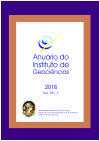Numerical Modelling of Travertine Mechanical Behaviour Based on Rock Mechanics Tests of Vertical Plugs
DOI:
https://doi.org/10.11137/2016_2_15_28Keywords:
Stress-strain behavior, Numerical modelling, Travertine.Abstract
Results of rock mechanics tests conducted on travertine plugs have been used to model the stress-strain behavior of this rock under confined and unconfined loadings, for future numerical representation of the intact rock surrounding fault zones, within a study about fault reactivation potential in carbonates. Due to the strain hardening tendency verified in most of the experiments results, a specific Mohr Coulomb model was applied, based on two different sets of cohesion, friction angle and dilation values. Although collapse events verified during the tests could not be captured by the modelling, it was possible to fit the dominant mechanical behavior of the rock, without relevant changes on the parameters measured during the experiments. The software used for this purpose was Tectos (PUC-Rio/Tecgraf - Petrobras), which considers plane strain state. As the experiments configure an axissymetric problem, future works will evaluate the representativity of plane strain model for this material and test conditions, through comparison of the current modelling results with the ones obtained using a different numerical tool.Downloads
Download data is not yet available.
Downloads
Published
2016-06-23
How to Cite
Kiewiet, M. C. D. N. (2016) “Numerical Modelling of Travertine Mechanical Behaviour Based on Rock Mechanics Tests of Vertical Plugs”, Anuário do Instituto de Geociências. Rio de Janeiro, BR, 39(2), pp. 15–28. doi: 10.11137/2016_2_15_28.
Issue
Section
não definida
License
This journal is licensed under a Creative Commons — Attribution 4.0 International — CC BY 4.0, which permits use, distribution and reproduction in any medium, provided the original work is properly cited.















